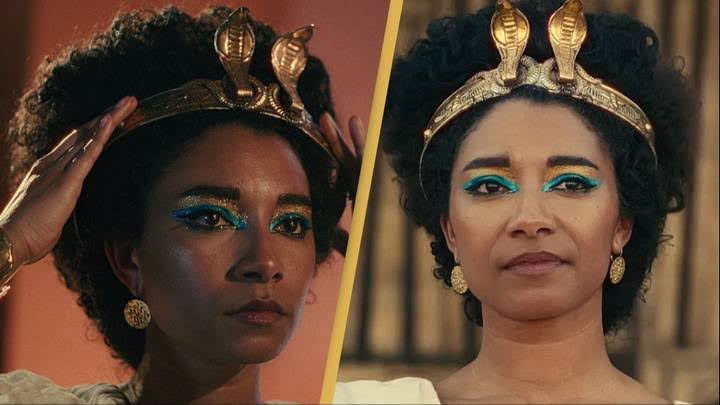Your basket is currently empty!

Historical Expert Destroys Netflix’s “Cleopatra” claims “they wrote it with their eyes closed”
The proverb of “all press is good press” feels almost as old as the Nile. Yet it’s being put to the test this week via the release of Netflix’s African Queens: Cleopatra. The documentary is the second of three from the streaming service and executive producer Jada Pinkett Smith, both of whom have committed to spotlighting women rulers in African history by way of historical reenactments (or “docudrama”) which is then juxtaposed against interviews with talking heads and experts.
Yet the veracity of the documentary aspect of the film is being aggressively challenged after Netflix’s Cleopatra cast Black British actress Adele James as Cleopatra VII Philopator, the last pharaoh of Egypt and the end of the Ptolemaic dynasty. The trailer even rather proactively includes a line from one of its interviewees, Professor Shelley P. Haley of Hamilton College, who said her grandmother once told her, “I don’t care what they tell you in school, Cleopatra was Black.”
So we thought it proper to see what the evidence suggests and take to the historical view claiming only historical evidence, could it be that they are painting this historical character dark skinned just to meet a narrative rather than accuracy? the following is a historical expert account:
The appearance of Cleopatra VII, the iconic queen of ancient Egypt, has long been a subject of speculation and debate. While the new Netflix documentary series suggested that Cleopatra had a dark complexion, a careful examination of the available evidence and historical context suggests that she was more likely to have had a fair complexion. For this reason and many more it’s obvious the Netflix documentary writing team had their eyes closed.
- Macedonian Greek Ancestry:
Cleopatra hailed from the Ptolemaic dynasty, which was of Macedonian Greek descent. The ruling Ptolemies were descendants of Ptolemy I, one of Alexander the Great’s generals. Greeks of this time were definitely light skin as is seen in all ancient artwork of the time, reflecting their European heritage. Given Cleopatra’s lineage, it is reasonable to assume that she shared the physical characteristics associated with her Greek ancestors. After all do we not look like our parents? Pretty safe to assume failing any “anomalies” that may occur?
- Cultural Identity and Integration:
While the Ptolemies were of Greek origin, they ruled over Egypt and sought to integrate into Egyptian society. As part of this effort, they adopted Egyptian customs and presented themselves as pharaohs in the traditional Egyptian style. This integration is often used to imply Cleopatra may have been a product of this integration but this does not necessarily imply that Cleopatra had a dark complexion. Rather, it highlights the complex intermingling of cultures in ancient Egypt and the political strategies employed by the ruling dynasty, whom usually kept within their “inner circle”
- Depictions in Ancient Art:
Although there are no surviving contemporaneous portraits of Cleopatra, we can examine the depictions of her that were created after her reign, primarily on coins and artwork. While these representations may not provide an exact likeness, they offer valuable insights into how Cleopatra was visually portrayed in the centuries following her death.
One notable aspect of these depictions is the portrayal of Cleopatra with distinct European features, which align with the prevailing image of Greek rulers of the time. Many of the artistic representations depict Cleopatra with a hooked nose, a feature commonly associated with ancient Greek depictions. This portrayal is consistent with the facial features typically attributed to Macedonian Greeks, from whom Cleopatra descended.
Moreover, these representations often depict Cleopatra with a fair complexion, indicated by lighter tones used in the artwork. While artistic conventions certainly played a role in shaping these depictions, they were generally based on the prevailing ideals of beauty and cultural perceptions of the time. The depiction of Greek rulers, who were seen as the epitome of beauty and refinement, tended to emphasize fair skin as a desirable trait.
It is important to note that ancient art was not necessarily intended to provide accurate portraits or exact representations of individuals. Artists often conveyed symbolic or idealized depictions, influenced by cultural and political factors. However, the consistency in portraying Cleopatra with European features and a fair complexion across different artworks and coins suggests a prevalent and enduring perception of her appearance.
Furthermore, these representations align with the broader historical context of the Ptolemaic dynasty and their Greek heritage. The ruling Ptolemies sought to maintain their Greek identity and were often depicted with light skin in ancient artwork. Cleopatra, as a member of this dynasty, would likely have shared the physical characteristics associated with her Greek ancestors, including a fair complexion.
- Historical Accounts:
Although there are no firsthand accounts of Cleopatra’s physical appearance from her contemporaries, the writings of ancient historians like Plutarch and Dio Cassius describe her intelligence, charisma, and captivating presence. These accounts focus on her character and political acumen rather than her physical attributes. If Cleopatra’s dark skin were indeed a defining feature, it is likely that it would have been mentioned explicitly in these accounts. Especially given her background and coming from a Greek background, as this would have been an anomaly at that time, in that place of the world at the time.
While the definitive appearance of Cleopatra remains elusive, the available evidence and historical context strongly suggest that she had a fair complexion. Her Macedonian Greek ancestry, the artistic representations of her time, and the lack of specific descriptions from contemporaneous sources all align with the likelihood of Cleopatra having pale skin. It is important to approach this topic with an understanding of the complex historical context and to avoid making definitive claims based on limited or speculative evidence. Cleopatra’s true appearance may forever remain a mystery, but the balance of evidence leans toward a fair-skinned queen of Macedonian Greek heritage.
by
Tags:
Leave a Reply